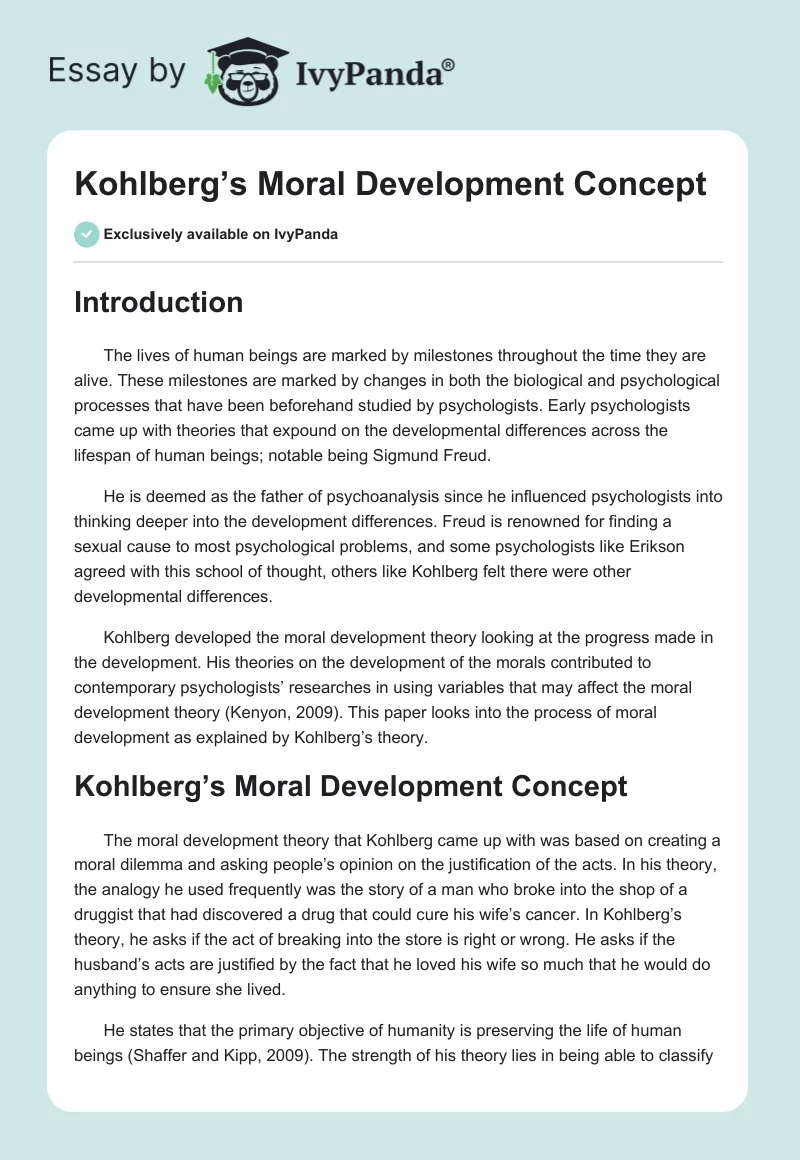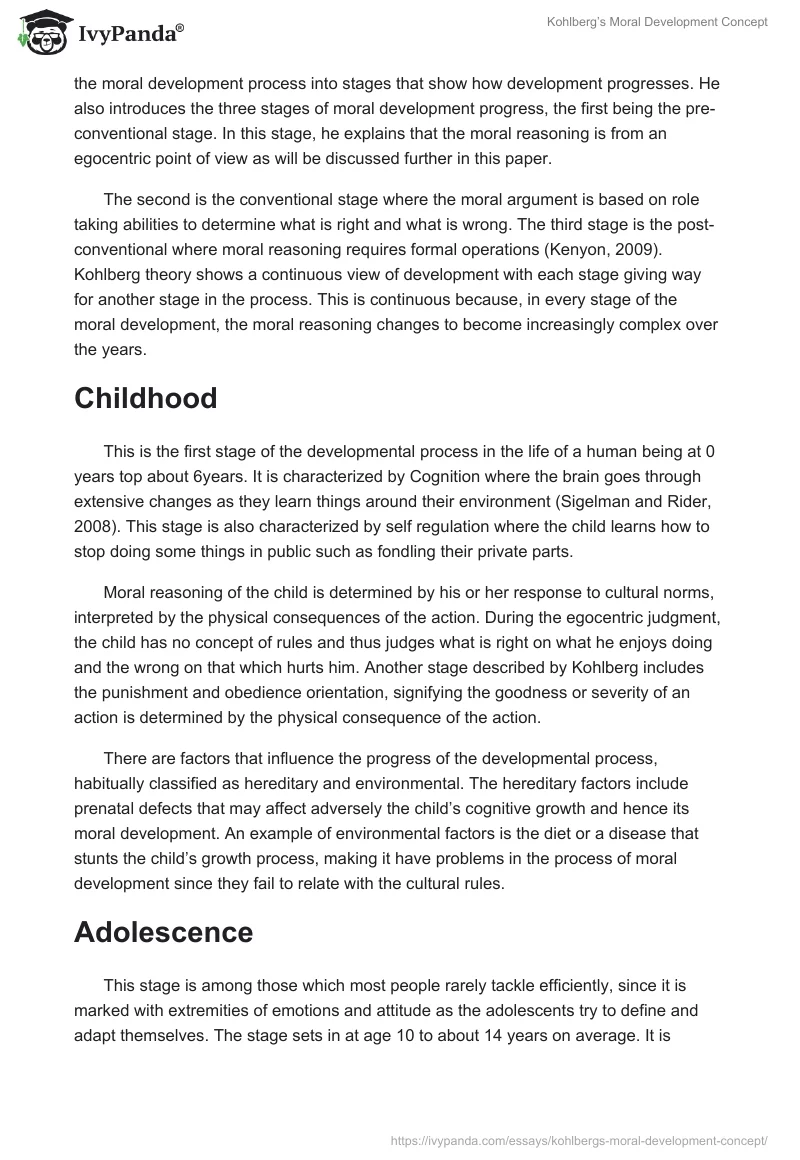Introduction
The lives of human beings are marked by milestones throughout the time they are alive. These milestones are marked by changes in both the biological and psychological processes that have been beforehand studied by psychologists. Early psychologists came up with theories that expound on the developmental differences across the lifespan of human beings; notable being Sigmund Freud.
He is deemed as the father of psychoanalysis since he influenced psychologists into thinking deeper into the development differences. Freud is renowned for finding a sexual cause to most psychological problems, and some psychologists like Erikson agreed with this school of thought, others like Kohlberg felt there were other developmental differences.
Kohlberg developed the moral development theory looking at the progress made in the development. His theories on the development of the morals contributed to contemporary psychologists’ researches in using variables that may affect the moral development theory (Kenyon, 2009). This paper looks into the process of moral development as explained by Kohlberg’s theory.
Kohlberg’s Moral Development Concept
The moral development theory that Kohlberg came up with was based on creating a moral dilemma and asking people’s opinion on the justification of the acts. In his theory, the analogy he used frequently was the story of a man who broke into the shop of a druggist that had discovered a drug that could cure his wife’s cancer. In Kohlberg’s theory, he asks if the act of breaking into the store is right or wrong. He asks if the husband’s acts are justified by the fact that he loved his wife so much that he would do anything to ensure she lived.
He states that the primary objective of humanity is preserving the life of human beings (Shaffer and Kipp, 2009). The strength of his theory lies in being able to classify the moral development process into stages that show how development progresses. He also introduces the three stages of moral development progress, the first being the pre-conventional stage. In this stage, he explains that the moral reasoning is from an egocentric point of view as will be discussed further in this paper.
The second is the conventional stage where the moral argument is based on role taking abilities to determine what is right and what is wrong. The third stage is the post-conventional where moral reasoning requires formal operations (Kenyon, 2009). Kohlberg theory shows a continuous view of development with each stage giving way for another stage in the process. This is continuous because, in every stage of the moral development, the moral reasoning changes to become increasingly complex over the years.
Childhood
This is the first stage of the developmental process in the life of a human being at 0 years top about 6years. It is characterized by Cognition where the brain goes through extensive changes as they learn things around their environment (Sigelman and Rider, 2008). This stage is also characterized by self regulation where the child learns how to stop doing some things in public such as fondling their private parts.
Moral reasoning of the child is determined by his or her response to cultural norms, interpreted by the physical consequences of the action. During the egocentric judgment, the child has no concept of rules and thus judges what is right on what he enjoys doing and the wrong on that which hurts him. Another stage described by Kohlberg includes the punishment and obedience orientation, signifying the goodness or severity of an action is determined by the physical consequence of the action.
There are factors that influence the progress of the developmental process, habitually classified as hereditary and environmental. The hereditary factors include prenatal defects that may affect adversely the child’s cognitive growth and hence its moral development. An example of environmental factors is the diet or a disease that stunts the child’s growth process, making it have problems in the process of moral development since they fail to relate with the cultural rules.
Adolescence
This stage is among those which most people rarely tackle efficiently, since it is marked with extremities of emotions and attitude as the adolescents try to define and adapt themselves. The stage sets in at age 10 to about 14 years on average. It is characterized by a growth spurt that is marked in height and size of the person, as well as hormonal changes that bring out a young woman or man.
This stage also shows an increased ability to use abstract thoughts. The adolescents start to recognize the preservation of the expectations of his family as precious regardless of the instantaneous consequences. This stage enforces conformity and loyalty to personal expectations and social order among societies (Newman and Newman, 2008). This is the conventional level, and it constitutes two levels.
The first is the interpersonal concordance orientation, which justifies the correct action as that which is widely accepted in the societal context. In this stage of orientation, the behavior is normally judged by the intention of the person. The second stage of this level is law and order orientation, where the individual is oriented into respecting the authority as part of right behavior (Kenyon, 2006).
Similar to the childhood stage, the moral development process in this stage is influenced the hereditary factors that were established at the childhood level. Impairments such as mental disorders may inhibit an individual’s ability to abide by the social norms. Other related factors include environmental attributes such as the company that an individual keeps, owing to how it appreciably determines the conformity level of the individual.
Adulthood
This stage is marked from an average age of 20 years to about 50 years of the human life span. It is characterized by an ability to initiate intrinsic motivation to carry out duties. It is also marked by a heavy sense of responsibility, and the person experiences a sense of autonomy (Newman and Newman, 2008). In this stage, the adults have reached the Post–Conventional or Principled Level where the individual strive to determine ethics accepted in the societal context, distinct from the association of the individual with the group.
The hereditary influences on the process of growth include genetically inherited diseases such as diabetes, which may cloud a person’s judgement on what is justified or wrong. There are other environmental factors that influence the growth process such as the work place. This may be strenuous and may eventually cause psychotic disorders, affecting the person’s judgment.
Conclusion
In the discussion of the different developmental stages, it is clear that social interaction and cultural norms plays a pivotal role in moral growth processes of human beings. Kohlberg’s theory proves to be correct since for wholesome development of human beings, the moral aspect needs to be fully developed in order to ensure a socially balanced community.
In the childhood stage, the person experiences egocentric judgment that involves judging acts as right or wrong according to how they make him feel. This gradually grows into the conventional level at adolescence where the individual resorts to conformity. It happens as the individual seeks approval from the other people. In adulthood, individuals make an effort to define moral more clearly.
References
Kenyon, R. (2009). Stages of Moral Development. Xenodochy. Web.
Lerner, R. (2002). Concepts and Theories of Human Development. New York: Routledge.
Newman, B., and Newman, P. (2008). Development through Life: A Psychological Approach. London: Cengage Learning.
Shaffer, D. and Kipp, K. (2009). Developmental Psychology: Childhood and Adolescence. London: Cengage Learning.
Sigelman, C., and Rider, E. (2008). Life-Span Human Development. London: Cengage Learning.


